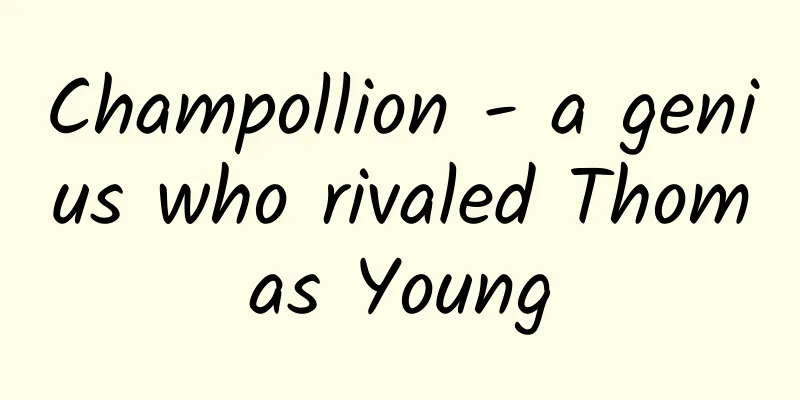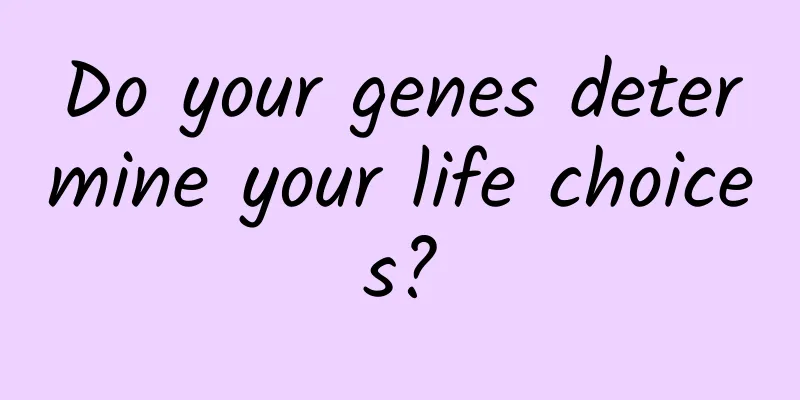Champollion - a genius who rivaled Thomas Young

|
French linguist Champollion systematically studied the Rosetta Stone. He was the first to discover that ancient Egyptian writing had both phonetic and semantic functions. He devoted his life to the study of ancient Egypt and was considered the founder of "Egyptology". However, at the same time as him, there was another all-round scholar who participated in the deciphering of the Rosetta Stone - Englishman Thomas Young (see "Thomas Young - The Last Man Who Knew Everything"). The two had a dramatic exchange and were well matched. Written by Chen Guanrong (City University of Hong Kong) French scholar Jean-François Champollion (December 23, 1790 - March 4, 1832) stayed in this world for a short 42 years, but he engraved his name in the long history of ancient Egyptian writing research. Figure 1 Portrait of Jean-François Champollion 1 The earliest Chinese oracle bone inscriptions were discovered in 1899 by epigrapher Wang Yirong (1845-1900), and later generations determined that the oracle bones were from the Shang and Yin dynasties (about 1600-1046 BC). Over the past 100 years, there have been about 4,600 different words in the more than 100,000 pieces of oracle bone inscriptions collected nationwide, of which only more than 1,100 are currently recognizable. Although the structure of the remaining characters is clear and the meaning of some can even be guessed, the pronunciation is almost impossible to determine. This shows that the exploration and research of ancient characters is by no means an easy task. Figure 2 Sample of Shang and Yin Oracle Bone Inscriptions The appearance of ancient Egyptian writing may be slightly earlier than that of Chinese oracle bone writing. It is also a hieroglyphic writing, and it is said that it was first engraved on the joint plate of the armor of Pharaoh Narmer (about 3100 BC). Ancient Egyptian writing was called Hiérpglyphe by Europeans, which is a compound word of the Greek words "sacred" and "inscription", also known as "sacred stele", and was later often written on "papyrus" (about 3000 BC). What is clearly recorded in historical records is that the research on ancient Egyptian writing was about a hundred years earlier than that on Chinese oracle bone inscriptions. In 1798, French commander Napoléon Bonaparte (1769-1821) led his troops to Egypt. The following year, the French expeditionary force discovered a "Rosetta Stone" while expanding the foundation of a fortress near the town of el-Rashid in Egypt. The stone was erected in 196 BC, with 14 lines of ancient Egyptian hieroglyphs engraved on the top, 32 lines of ancient Egyptian cursive in the middle, and 54 lines of ancient Greek in the bottom. Later, it was found that these three texts were about the same thing, which was the edict of the ancient Egyptian pharaoh Ptolemy V (Ptolemaic V, about 209-180 BC). However, because the text in it had long been abandoned, no one knew the content of the inscription at the time. Figure 3 Ancient Egyptian Rosetta Stone (photo) In the autumn of 1799, Napoleon left behind the army he had brought to Egypt and quietly returned to France, where he seized power through the "Brumaire Coup". However, the French army that remained in Egypt suffered a disastrous defeat in the battle with the British army in 1801 and surrendered. The British army then seized the Rosetta Stone and transported it back to Britain in 1802. Later, King George III of England donated it to the British Museum in his own name. From then on, the Rosetta Stone was placed in the Egyptian Hall and became the treasure of the museum. Figure 4 Ancient Egyptian Rosetta Stone (British Museum) The discovery of the Rosetta Stone attracted the attention and research of many archaeologists and philologists, one of whom was the most influential, the Swedish Orientalist Johan D. Åkerblad (1763-1819). Åkerblad's tutor when he was studying in Paris was the linguist and Orientalist Silvestre de Sacy (1758-1838). Sacy had already examined the Rosetta Stone and read out the names of five people. Åkerblad inherited his research work and identified the correct pronunciation of about half of the 29 symbols. However, he mistakenly believed that the hieroglyphs on the stone corresponded to an alphabet. In 1810, Åkerblad sent his report to de Sacy for publication, entitled "Memorandum: On the Coptic Names of Some Towns and Villages in Egypt". However, for some reason, the publication of the book was delayed and it was not officially released until 1834. The "Coptic" in the title is a language (Coptic Language), which is a late form of ancient Egyptian, a combination of ancient Greek and ancient Egyptian, and also has a unique alphabet. Coptic was later gradually replaced by Egyptian Arabic, but it is still used in some ancient traditional churches in Egypt today. A key figure in the deciphering of the Rosetta Stone was the British polymath Thomas Young (1773-1829). Thomas Young initially used Oakblade's hieroglyphic alphabet. In 1814, he roughly interpreted the inscription using an alphabet supplemented with 86 hieroglyphic symbols, deciphering the names of 9 of the 13 royal family members, and also pointed out the correct reading of the hieroglyphic symbols on the top of the inscription, which was later published in a book. Thomas Young was very knowledgeable about language and writing. He had compared about 400 languages and proposed the classification of "Indo-European languages" in 1813. In 1819, Thomas Young published an important article on Egypt in the Encyclopedia Britannica, explicitly claiming that he had discovered the basic principles of the Rosetta Stone text. After Thomas Young died, his descendants engraved a eulogy on his tombstone: "He was the first to decipher the ancient Egyptian text that no one had been able to decipher for thousands of years." Next, French scholar Champollion discovered that hieroglyphics have both phonetic and semantic functions. This statement was initially questioned, but gradually recognized by the academic community. Champollion generally identified the meaning of most phonetic hieroglyphics and reconstructed most of the grammar and vocabulary of ancient Egyptian. He made an indelible contribution to the history of human writing. Thomas Young and Champollion had communicated, but the story was quite dramatic. In 1814, Champollion published Egypt Under the Pharaohs in two volumes. In the same year, he wrote to the Royal Society of London asking him to give a better interpretation of the Rosetta Stone. Thomas Young, who was the secretary of the society at the time, was unhappy after receiving the letter and gave a negative reply the following year, saying that the French proposal was not much different from the existing version in the UK. That was the first time Champollion knew about Thomas Young's research on ancient Egyptian writing, and realized that he had a strong competitor in London. After that, the two kept their investigations and research work secret from each other, and there was no more correspondence. In fact, Champollion began to study the Rosetta Stone through the rubbings of Abbé de Tersan as early as 1808. In 1822, Champollion officially published the results of his comprehensive research on the translation and grammatical system of hieroglyphics. In his "Letter to Dacier on the Phonetic Hieroglyphic Alphabet" to Bon-Joseph Dacier (1795-1833), the president of the French Academy of Letters, he systematically reported the results of deciphering the ancient Egyptian hieroglyphics on the Rosetta Stone. He wrote: "I believe that long before the Greeks came to Egypt, the same phonetic symbols were used in their hieroglyphs to represent the pronunciation of Greek and Roman proper names, and that these reproduced sounds or pronunciations are consistent with the scroll patterns previously carved by the Greeks and Romans. The discovery of this important and decisive fact is entirely based on my own research on pure hieroglyphics." Like many of his colleagues, Thomas Young also publicly praised his work. However, Thomas Young is said to have subsequently published a report on new discoveries in hieroglyphics and ancient Egyptian writing, suggesting that his work was the basis for Champollion's research. Figure 5 From a letter from Champollion to the president of the French Academy (1822) From 1822, Champollion devoted himself to in-depth study of Coptic, which was an essential tool for Egyptian archaeology, and on the other hand, he devoted himself to studying ancient Egyptian history and secular life and trying to explore the musical and artistic heritage of ancient Egypt. Between 1824 and 1826, Champollion visited museums in Cambridge, Turin, Florence, Naples, Rome, Geneva and Lyon, and studied hundreds of ancient Egyptian texts on stone tablets, statues, mummies and papyri. Today, the National Library of France still has many of Champollion's manuscripts, including archaeological maps, text interpretation notes, etc. Among them, there are many hand-drawn drawings related to Egyptian texts, as well as his copies of stone tablets, statues and even sarcophagus traces. Fig. 6 Champollion’s copy of the sheep on the fragment of the Temple of Amun (1824-1826) In 1828, Champollion led a Franco-Tuscan expedition to Egypt for two years. During this period, they mainly stayed in the upper reaches of the Nile, especially in Karnak on the east bank. There, Champollion deciphered the secrets of the ancient texts on the walls and columns of the Temple of Amun. On January 1, 1829, he wrote to Bon-Joseph Dacier, president of the French Academy, saying, "I can proudly announce that I have completed the route along the Nile from its mouth to the second waterfall. We do not need to change anything in our existing hieroglyphic alphabet. Our alphabet is good: it can be successfully used for inscriptions on Egyptian monuments from the Roman and Ptolemaic eras, and more importantly, on all temples, landmarks and tombs of the Pharaoh era. All this supports the encouragement you gave me when hieroglyphic work was far from being taken seriously." After the Egyptian survey, he exclaimed: "No nation, past or present, can conceive such lofty, vast and magnificent buildings as the ancient Egyptians." Many of his survey results were compiled by later generations in the collection of documents "Monuments of Egypt and Nubia" published in 1845. Thomas Young died in 1829, followed by Champollion in 1832, and the deciphering of ancient Egyptian writing came to a halt. However, by the 1850s, the ancient Egyptian writing had been basically sorted out. In the comments and disputes of academic descendants, it can be seen that the British generally supported Thomas Young, while the French generally admired Champollion. All this seems to be reasonable. Figure 7 Champollion’s drawings and notes (1828-1829) 2 Champollion was born on December 23, 1790 in the town of Figeac in southern France. His father, Jacques Champollion (1773-?), was a bookseller. He was the youngest of seven siblings. His eldest brother, Jacques-Joseph (1778-1867), was 12 years older than him and was his childhood caretaker and future life mentor. Champollion was not good at studying when he was young, but he was found to have great language talent and could speak several different foreign languages. When he was 8 years old, he read the news that Napoleon led his troops to invade Egypt in the newspaper of his father's bookstore. He was attracted and became a greedy little reader of the Egyptian Messenger. In 1801, he followed his brother to the University of Grenoble to study linguistics. At the university, he mastered Latin, Greek, and a certain level of Hebrew, Amharic, Indian Sanskrit, Avestan, Pahlavi, Arabic, Syriac, Chaldean, Persian and Chinese. In a letter to his brother in 1806, after graduation, he said: "I want to make a long and lasting study of the ancient country of Egypt. I am filled with a passion to explore their monuments, their power and knowledge. As I grow older and acquire new knowledge, this passion will continue to grow. Of all the people I love, I would say that none is more important to me than the Egyptians." In 1807, he entered the College de France to specialize in Oriental languages. During this period, he felt that the lack of a chronological table of major events was not conducive to the study of history and linguistics, so he compiled a chronological table of the history of the Pharaoh Dynasty, named "Chronology from Adam to Champollion the Younger". In 1809, he received his doctorate in literature and became assistant professor of history at the University of Grenoble, where he taught until 1816. During this time, he married Rosine Blanc (1794-1871) in 1812, with whom he had a daughter (Zoraïde, 1824-1889). In 1818 he accepted an invitation to become head of the history and geography departments of the Royal Institution, where he remained until 1821. In 1824, he published the monograph "Introduction to the Hieroglyphic System", which is considered to have pioneered the discipline of "Egyptology". In 1826 he was appointed curator of the Egyptian section of the Louvre Museum. In 1831 he returned to the Collège de France as professor of Egyptology and president of the Egyptological Society. On March 4, 1832, Champollion died of a stroke and internal bleeding in Paris at the age of 42 and was buried in Père Lachaise Cemetery. Figure 8 Tombstone of Champollion (Paris) The manuscript "Ancient Egyptian Grammar" left by Champollion when he died was compiled by later generations and published in 1836. In 2004, the French Egyptology Society held the 9th International Conference on Egyptology in the town of Grenoble, where Champollion's brother Jacques Joseph lived and worked. At the same time, it began to plan the construction of the "Champollion Museum" in a nearby place called Vif, which will be officially open to the public after its completion in 2021. Figure 9 Some of Champollion’s books (translated) 3 Ancient Egypt is one of the four ancient civilizations. Egypt not only has the natural Nile River and the Sahara Desert, but also has a brilliant culture created and left by its ancestors. In addition to hieroglyphics, Egypt also left behind pyramids, mummies, palaces, temples, papyrus, etc., as well as many fascinating myths. However, the ancient Egyptian writing was not interpreted and passed down by the descendants of the Egyptians, which is a great pity. However, the ancient Egyptian sages may not blame their descendants. Unlike the civilizations of China, ancient India, and ancient Greece, the civilization of ancient Egypt, like the ancient Babylonian civilization, was an ancient civilization that had been interrupted or annihilated. In the second half of the 4th century BC, Alexander the Great (356-323 BC) of Macedonia in ancient Greece conquered ancient Egypt and used ancient Greek as the official language there. In the second half of the 1st century BC, ancient Rome conquered ancient Egypt again, destroyed most of the ancient Egyptian artifacts and promoted ancient Latin there. In 529, the Roman King Justinian I (about 482-565) also ordered the closure of all temples and cultural gathering places in Egypt. The last great disaster in Egypt occurred in 644, when the powerful Arabs completely conquered Egypt, switched to Arabic and converted to Islam throughout the country. After a thousand years of looting, even the remaining ancient Egyptian characters and documents were destroyed, and the heritage of ancient Egyptian civilization no longer existed. It is believed that if it were not for the amazing discoveries of Thomas Young and Champollion, the Egyptians might not have known until now that their ancestors once had perhaps the oldest complete hieroglyphics in human history. Figure 10 Khufu Pyramid and Sphinx in Egypt Special Tips 1. Go to the "Featured Column" at the bottom of the menu of the "Fanpu" WeChat public account to read a series of popular science articles on different topics. 2. Fanpu provides a function to search articles by month. Follow the official account and reply with the four-digit year + month, such as "1903", to get the article index for March 2019, and so on. Copyright statement: Personal forwarding is welcome. Any form of media or organization is not allowed to reprint or excerpt without authorization. For reprint authorization, please contact the backstage of the "Fanpu" WeChat public account. |
<<: Yellow, black, red, transparent... What are these various colors of tape used for?
>>: The 45-year-old Voyager 1 sent back confusing information. What did it encounter in deep space?
Recommend
App Store Market Optimization Tips and Strategies!
As the leader of the third-party application mark...
To attract traffic to your product, you need to master the three "relative truths" of traffic promotion
Generating traffic is essentially about generatin...
Why is the “Maluo emoticon package”, which is deified by young people, a monkey?
Looking back at the year 2023, there have been ma...
The most comprehensive analysis of Kuaishou information flow account establishment and delivery!
This article mainly briefly introduces the backgr...
WeChat Mini Program Mid-Year Report: With Over 600 Million Users, Where Is the Profit Space for Mini Programs?
[[237014]] The picture comes from the Internet 1 ...
Kuaishou Brand Self-broadcasting Methodology
Branded self-broadcasting is undoubtedly the hott...
K12 Online Education User Growth Traps
Education is one of the best means of transferrin...
Starting from NetEase Cloud Music, how to quickly acquire a large number of target users!
How can we quickly acquire a large number of targ...
Why do humans want to explore asteroids?
Asteroids are celestial bodies that orbit the sun...
Learn how to use the AARRR model to achieve user growth in one article
" User growth is essentially a precise, low-...
Zhuhai Photography Mini Program Customization Price Inquiry, How much does Zhuhai Photography Mini Program Customization cost?
There is no doubt that the topic of mini programs...
2022 Postgraduate Entrance Examination Political Science Course Resources - Gaotu, Xinwendao, Haitian, Wendu, New Oriental, Xiao Xiurong Postgraduate Entrance Examination Political Science
17. 2022 Yu Feng 16. 2022 Higher Education Online...
How do Internet finance platforms retain users?
Although new media operations cannot effectively ...









